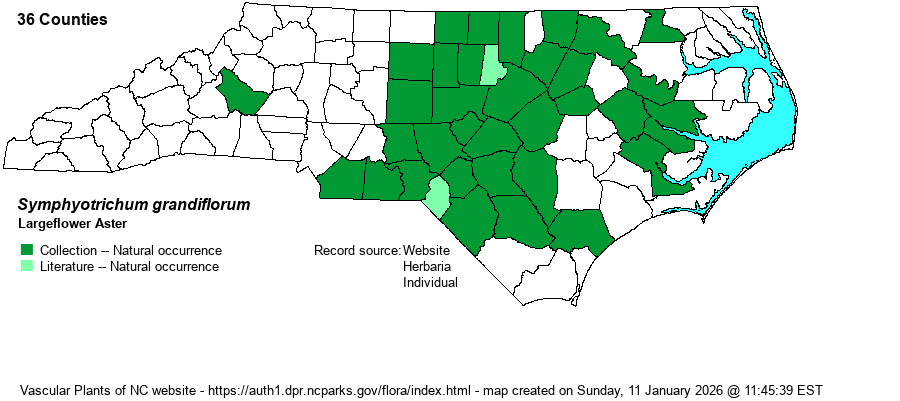| Author | (L.) Nesom | |
| Distribution | Eastern 40% of the Piedmont, Sandhills, and most of the Coastal Plain; disjunct to Table Rock Mountain in Burke County. Apparently absent from the outer Coastal Plain.
A surprisingly small range -- central VA to central SC. | |
| Abundance | Frequent to locally common, but clearly declining (as of the 2020s), in the eastern Piedmont and western Coastal Plain, and fairly common in the Sandhills. Infrequent into the central Coastal Plain, east to Hertford and Beaufort counties. Rare to absent near the coast, and in the western half of the state. The State Rank is clearly S4 and not the very conservative S3. The spread of robust, yellow-flowered composites -- such as Bidens aristosa and several Verbesina species -- has greatly impacted this and other smaller native composites of woodland margins. | |
| Habitat | Dry to mesic, sandy to clayey, soils of pine-deciduous woodlands, woodland and forest borders, fields, powerlines, roadsides. Favors partial shade of wooded borders. | |
| Phenology | Flowering and fruiting late September - mid-November. | |
| Identification | Largeflower Aster is a busy, bushy-looking plant, mostly 2-4 feet tall; its stems are coarsely hairy. Midstem leaves are stalkless and clasp the stem, lance-shape and widest towards tip, the upper surface rough; upper stem leaves are smaller, stalkless but non-clasping, mainly elliptical, and less rough. The very numerous and large, showy heads have long violet to purple rays and yellow disks; note also the recurved involucral bracts. It is not likely to be confused with other asters owing to its numerous small leaves and quite bushy, robust (semi-woody) stature with very large flowers for an aster. Indeed, it is a very handsome plant! | |
| Taxonomic Comments | NOTE: The genus Aster was examined by G.L. Nesom (1994), who determined that it was composed of a number of discrete genera (a few of which were already split off by authors as Sericocarpus, Ionactis, etc.). The earliest available name for North American "Aster" is Symphyotrichum, a name regrettably long and hard to spell.
| |
| Other Common Name(s) | Big-headed Aster | |
| State Rank | S3 [S4] | |
| Global Rank | G4 | |
| State Status | | |
| US Status | | |
| USACE-agcp | | |
| USACE-emp | | |

